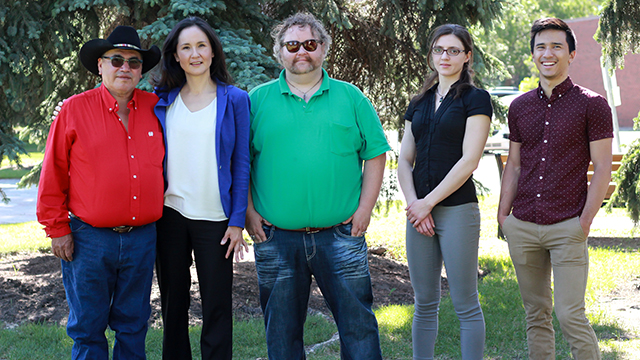
Several members of the IGS working group. From left to right: Elder Rick Lightning, Tibetha Kemble, Kenton Boutillier (IHIP), and MD students Bernardine Jugdutt and Paul Barber.
The University of Alberta Faculty of Medicine & Dentistry will welcome the 2018 academic year in August with a new Indigenous Gathering Space (IGS) for student use.
Located on the second floor of the Katz Group Centre for Pharmacy and Health Research building, the IGS will serve as a teaching, ceremony and meeting space for community members and both Indigenous and non-Indigenous students from all the faculty's programs.
The idea was first conceived by the faculty's Indigenous Health Initiatives Program (IHIP) in the Division of Community Engagement, and came to fruition in partnership with the Medical Students' Association (MSA), Faculty of Medicine & Dentistry students and external partners.
"Part of the strategic process when approaching the future of the Indigenous Health Initiatives Program was to ensure Indigenous students had what they needed to be successful and to strengthen their connection to their communities, to each other and their unique cultures and identities," explained Tibetha Kemble, director of the IHIP. "When I looked around, it was hard to see Indigenous Peoples here-or see a place for us. I recognize that the concepts of place and gathering are central to Indigenous identity. I wanted to honour that."
Kemble began a search for an available space with a central location for students from the different programs, with the help of the Faculty of Medicine & Dentistry Facilities & Planning Projects team. A room owned by the MSA was identified as an option, and soon the MSA and Kemble were meeting to advance the proposal to the association's Executive Council and at the MSA's general meeting. The project received the green light, and the association offered to provide the funds for refurbishment and supplies to further solidify their support.
A public invitation to students and partners helped establish a working group responsible for making the space a reality and for defining its mission, vision and principles. Kemble also reached out to Elder Rick Lightning from Maskwacîs, who has participated as an advisor on the details of the space layout, and how it can best support Indigenous students and honour Indigenous ways of knowing and being. The working group includes medical students, members of the MSA, Indigenous students and external partners.
"We were honoured to participate in the project alongside the other Indigenous Gathering Space group members," said Kris Janvier, health policy analyst for the Treaty 8 First Nations of Alberta. "Treaty 8 and the IHI program share a common goal in supporting First Nations students who enter health career programs. Involving external partners is such a crucial part of the initiative as we look to create a space that is representative of all Indigenous groups in Canada."
"I think this space is important for current and future Indigenous medical students because it will help to facilitate a sense of community," said Lauren Cormier, current Indigenous MD student at the U of A. "It is a safe space where we can meet and do activities that are specific to our culture. It shows the faculty supports the unique needs of our Indigenous students as they go through their programs. I also hope that having a visible space will help future Indigenous students to choose the U of A for their degree."
"Being Indigenous means something different to each individual and we don't fit into one box." -Lauren Cormier, MD student
The new gathering space will be officially open for the 2018 Orientation Week in August. The space will undergo small renovations over the summer months with the help of working group members and the guidance of the Elder.
The space presents an opportunity for Indigenous students to honour, explore and strengthen their culture and identity.
"Many Indigenous students that I've talked to, myself included, didn't grow up with a strong Indigenous community or culture, and I hope that Indigenous students take advantage of the space to learn more about who we are as a culture and use it as a tool for self-discovery," added Cormier. "When people find out I'm Métis, suddenly I am supposed to know everything about Indigenous cultures-not only my own Cree culture but other groups from across Canada and the U.S. The expectation to have all the answers can be difficult to deal with."
"Being Indigenous means something different to each individual and we don't fit into one box."
The working group members hope the space will also help bridge gaps between Indigenous and non-Indigenous students, and exchange knowledge about what makes everyone unique. They want Indigenous students to feel "at home" and see themselves represented within the faculty.
"Indigenous students tend to think that there is some idealized concept of what a health sciences student must be, and that what they bring is somehow a deficit," said Kemble. "But actually the beauty of what Indigenous students bring into their programs rests precisely with the differences that comes from their experience and lived-reality. That is what that makes them such a valuable part of this faculty."
Kemble continues to build partnerships within the faculty and with external groups to expand the project to additional spaces. She anticipates additional shared spaces for learning and collaboration will be become available in the future. In the meantime, she emphasizes her excitement about the first space, a project that has been under development for some time.
"Having Indigenous gathering spaces and visible representations of culture and identity around, signals that we see Indigenous students and, in turn, they can see themselves. Over the long term I'd like to see this space becoming symbolic of something bigger, a symbolic way to say 'we are here'."